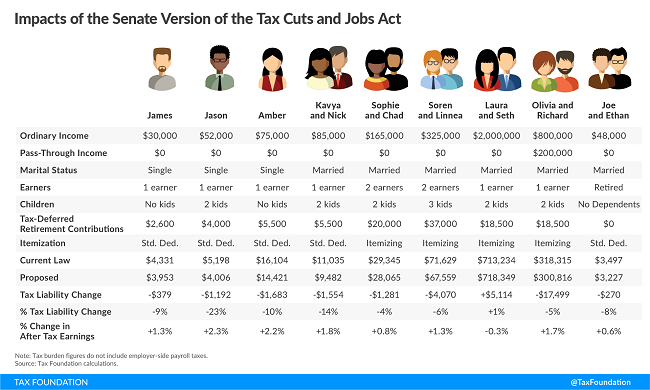The new Tax Cuts and Jobs Act is official and will affect millions of Americans and businesses. Here are the key provisions of the final bill:
INDIVIDUALS
Individual rates: Congress will keep the seven tax brackets as it previously had, but the range of income will change. The new rates are 10%, 12%, 22%, 24%, 32%, 35% and 37%.
Standard deduction: The amount of standard deduction has increased from $6,350 to $12,000 for single filers and $12,700 to $24,000 for married filing jointly. The increase means that fewer people will be able to itemize their deductions, but will also benefit those who do not itemize.
Personal exemption: Deductions for personal exemptions are now repealed. For 2017,
taxpayers can claim $4,050 personal exemption for themselves, their spouse, and their dependents, which will ultimately reduce taxable income. With this deduction repealed, taxpayers will lose this tax deduction, however, many will benefit from the higher standard deduction.
State and local tax deductions (SALT): Taxpayers are allowed to deduct the state and local tax, but it will now be limited to $10,000. Originally, the deduction was unlimited.
Child tax bracket: The bill will increase the child tax credit from $1,000 to $2,000 for children under the age of 17. The child tax credit will also now help taxpayers in the higher-income brackets since the threshold will increase. Taxpayers who earn $200,000 for single and $400,000 for married filing joint will be able to claim the entire credit. And, this credit is now refundable, meaning taxpayers who have leftover credits after deducting all taxes will be able to take this refund into their pockets.
Temporary credit for non-child dependents: A new tax credit for dependents who are not children, such as a child 17 or older, allows taxpayers to claim a $500 temporary credit.
Mortgage interest deduction: Taxpayers planning on buying a new home will only be able to deduct interest on the first $750,000 of mortgage interest. This will not affect any current homeowners. However, taxpayers will no longer be allowed a deduction for the interest on home equity loans that is currently allowed on loans up to $100,000.
Alternative Minimum Tax (AMT): Fewer taxpayers will be subject to Alternative Minimum Tax because the income exemption will increase to $70,300 for single and $109,400 for married filing joint.
Estate tax: More taxpayers are exempt from estate tax. This is because the amount exempt has now doubled. Previously the threshold was $5.49 million for individuals and $10.98 million for married filing joint.
Preserves popular tax breaks: Earlier versions of the bill sought to repeal certain deductions, but taxpayers are still allowed deductions for student loan interest, out of pocket school supplies purchased by teachers, and expands deductions for medical expenses only for the next two years.
Other deductions repealed: A couple of deductions are repealed. These include tax deductions for alimony payments for taxpayers who divorce after December 31, 2018, moving expense deductions, and miscellaneous deductions subject to a 2% limit.
Health insurance: In 2019, taxpayers who don’t have health insurance will not be penalized.
BUSINESS
Corporate tax rate & AMT: The corporate tax rate has been reduced and the multi-bracket calculations are gone. Now there is a single-rate of 21%, while the Alternative Minimum Tax for corporations has been repealed.
Pass-through deduction: Owners of pass through entities such as S Corporations, LLCs, and partnerships who pay corporate tax through their personal tax returns will have a 20% deduction. This will be limited to the greater of (a) 50 percent of wage income or (b) 25 percent of wage income plus 2.5 percent of the cost of tangible depreciable property for qualifying businesses, however, certain service providers will be limited. There will also be limitations relating to both caps and exclusions do not apply for those with income below $315,000 (for married filing joint filers).
Capital investment: Corporations can deduct the full (100 percent) expensing of short-lived capital investment for five years (phase-out over the subsequent five) and raises the section 179 to $1 million (phase-out starting at $2.5 million).
Net operating loss (NOLs) provisions: The carryback of net operating loss is eliminated, however, NOLs can be indefinitely carried forward limited to 80 percent of taxable income.
International income: Corporations that are multinational will be taxed according to a new territorial system with anti-abuse rules instead of a worldwide system of taxation.
YEAR-END STRATEGIES
Property tax payments: Most tax years span between 2017 and 2018. As a result, if you believe your “SALT” deduction will be more than $10,000 for the 2018 year, you can consider paying your property tax falling in the 2018 period before December 31, 2018 and take the write-off in the 2017 year.
Charitable contributions: Due to the higher standard deduction, your contribution may not be large enough to itemize for 2018. If this is the case, you can consider accelerating some charitable giving into 2017.
Misc. deductions: Employee business expenses and expenses such as investment fees, advisory fees and tax preparation fees will longer be deductible for 2018. You can consider accelerating these expenses to 2017 (such as prepaying your tax preparation costs) to maximize the benefit for your 2017 taxable year.
Moving expenses: These will no longer be allowed as an adjustment to income for 2018. Consider accelerating whatever you can to 2017 and discussing the implication with your employer.
AMT: Due to the increase in the AMT threshold, push off items (such as exercising ISOs) to 2018 if it means you won’t be subject to AMT.
Lower tax rates: The new tax law reduces the tax rate for many individuals. Although individual scenarios vary, taxes may decrease for a vast majority of individuals. In addition, many businesses, including those operating as pass-throughs (S corps and partnerships) may see significant savings. The general plan of action to take advantage of lower tax rates next year is to defer income into next year.
These are just some of the highlights of the new tax bill and is not meant to be a complete list of all the changes. As the Internal Revenue Service and Congress work to implement the new tax law, further guidance may be provided and we will incorporate these in any tax planning opportunities. Furthermore, each individual scenario is different and we advise you to review your taxes with us to understand the implications for your situation.





